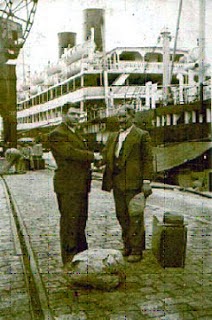Circa nel 1920, tanti italiani sono emigrati sulla costa di Santa Cruz in California.
Louis Poletti era uno di questi emigranti.
Nel libro quì di seguito presentato, l'autore descrive questa specifica zona americana.
titolo del libro:
LA NOSTRA COSTA # 34082
Il Viaggio d'una Famiglia Andata e Ritorno dalla Costa del Nord di Santa Cruz, California
Autore: Ivano Franco COMELLI
Editore: AUTHORHOUSE PRESS RELEASE - MARCH 2006
La storia dell’ autore comincia à Nimis, un piccolo villaggio agricoturale nella zona nord est d'italia chiamata Friuli. L'anno era il 1923.
Benito Mussolini e suoi fascisti in camicia nera avevano preso il potere. Il padre dell’ autore, Gervasio Comelli, doveva decidersi. Di aggiungersi di nuovo nell’ esercito o venire in America. Ha scelto il secondo proposito. Conoscendo altri emigranti che avevano scelto la severa costa del nord della contea di Santa Cruz per costruire loro case, Gervasio si decise di fare la stessa cosa. Situato pochi chilometri a sud di San Francisco, Gervasio trovò lavoro facendo l'agricoltore. Questi posti, chiamati ranches in inglese, gli italiani li chiamarono ranci. I lavoranti dunque erano ranceri. Questo posto fu nominato "La Costa".
Siccome Gervasio sapeva poco di questo mestiere, gli altri ranceri gli diedero il nomigliolo di Bronco (cavallo selvatico). Bronco fece presto ad’abituarsi al suo nuovo lavoro. Bronco lavorò nei ranch dal 1924 fino al 1931. Poi tornò à Nimis per cercare moglie. Quindi trovò Valentina Bressani, una bella e vivace fanciulla 17 enne. Facendole la testa piena di storie meravigliose del'america e come era facile guadagnare soldi là, l'innamorato Bronco convinse Valentina di sposarlo. Poi tornò “sulla costa”, con la promess, per la sua giovane sposa, che non appena Le avrebbe procurato i documenti necessari, l’avrebbe fatta venire anche lei in America.
Valentina arrivò “sulla costa” nel 1933. Ben presto scoprì che le storie di Bronco sui soldi facili non erano più attuali. L’America era sul fondo della depressione economica e quindi non ha trovato altro che lavoro faticoso e i venti infernali della severa costa del nord.
Usando eventi storici, mescolando cognomi locali con figure storiche, alcune famose, altre poco conosciute, come Franklin Roosevelt, Harry Truman, Herbert Hoover, Joe DiMaggio, Benito Mussolini, Adolf Hitler, ed Alfonso “Al” Capone, l'autore fa rivivere l'avventurosa storia degli emigranti italiani che vivevano e lavoravano “su per la costa”. Tra suoi occhi di giovane, ci dice come trascorreva la vita per la sua famiglia; dichiarati d'essere stranieri nemici durante la seconda guerra mondiale. Allo stesso tempo, ci riporta di nuovo à Nimis in Italia, e ci racconta come erano le condizioni di vita dei loro parenti che vivevano sotto la dura pressione dell’occupazione da parte delle forze naziste.
Ci racconta la storia della sorellina di Valentina che è sopravissuta alla guerra, poi trovandosi tacciata, dai partigiani, di essere una collaboratrice dei fascisti.
Di come sua madre ebbe la saggezza di farla venira in America.
L'autore, usando dettagli e numerose foto, dipinge la vita per la gente della costa, come vivevano, come parlavano, cantavano, brontolavano, e bestemmiavano. Nel suo proprio stile "saporito", ci dice anche come sua madre faceva la cuoca per i ranceri.
Nel mondo dell'autore,davanti alla televisione ed ai video-giochi, descrive come egli e i suoi amici di gioventù si divertivano giocando nella "grande piazza di ghiaia" e sulla loro spiaggia privata. Con un po' di “humor”, ci dice come egli e suoi giovani amici, praticando una loro forma di “voyerismo” grossolano, hanno scoperto di nascosto come gli umani si riproducono. Dunque, essendo cosi istruiti, l'autore spiega come i ragazzi della squadra della "piazza di ghiaia" si si accingevano alla ricerca delle dolci fanciulle
Nel 1959, l'autore partendo dalla costa, entrò nel corpo della polizia di San Jose. Qui molto freddamente descrive come la sua vita venne cambiata per sempre da certi atti di violenza, per esempio, l'assassinio del suo migliore amico. Usando eventi di attualità, l'autore ci dà una panoramica del mondo un po’ nebbioso della polizia di quegli anni e sottolinea le sue regole personali che ha seguito per sopravvivere in quel periodo.
A quei lettori ai quali piace la storia espressa in forma narrativa e contestualizzata nella vita quotidiana delle persone, il libro “La Nostra Costa” è ottimo. Questa storia, prima d'ora mai scritta, potrà intrattenere il lettore sfogliando pagine, cercando il risultato del viaggio di questa famiglia verso la costa e di ritorno.
Publicato da Authorhouse publishers, all’indirizzo:
http://www.authorhouse.com/. Per favore di fare connessione con nostra libreria ed inserire il nome del'autore: Ivano Franco Comelli; oppure il titolo del libro "La Nostra Costa". Si puo ordinare per telefono 001.888.280.7715. Si puo anche visitare La Nostra Costa Blog:
http://www.nostra-costa.blogspot.com/





